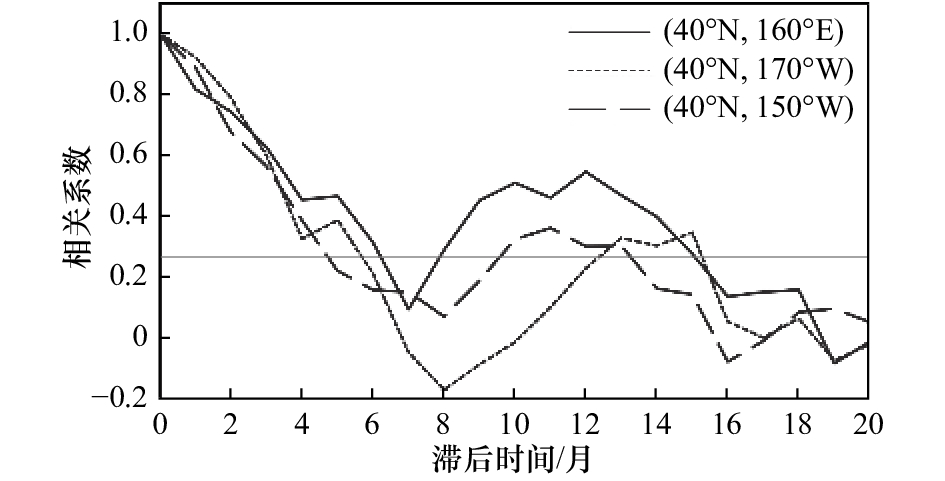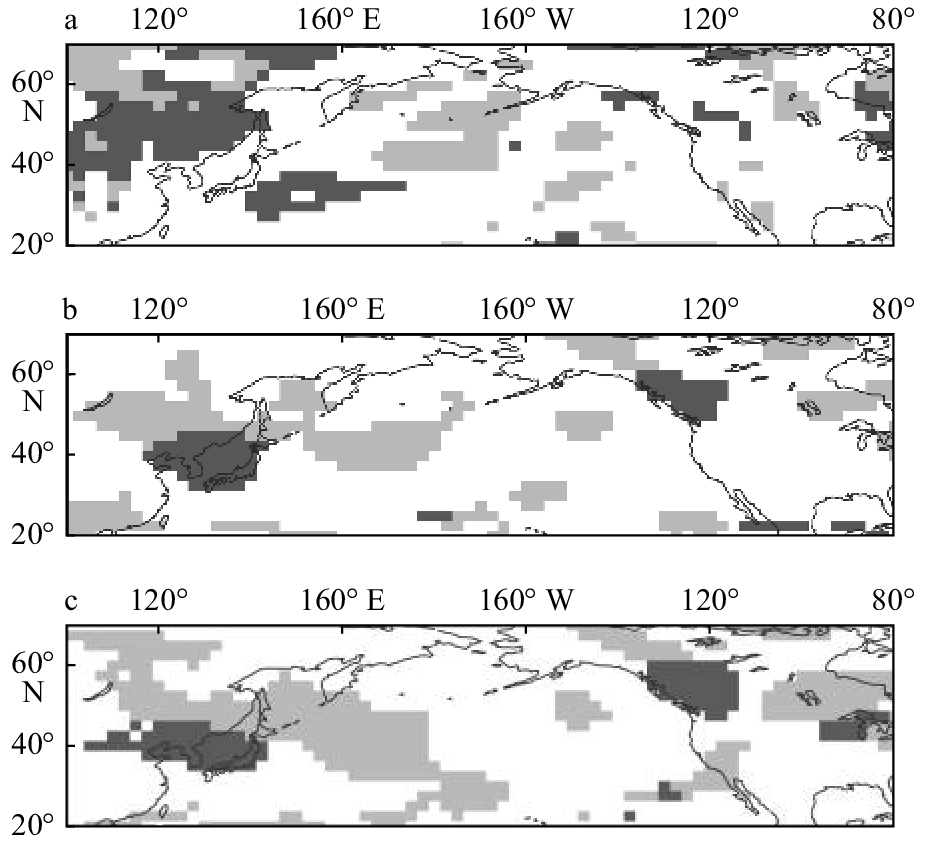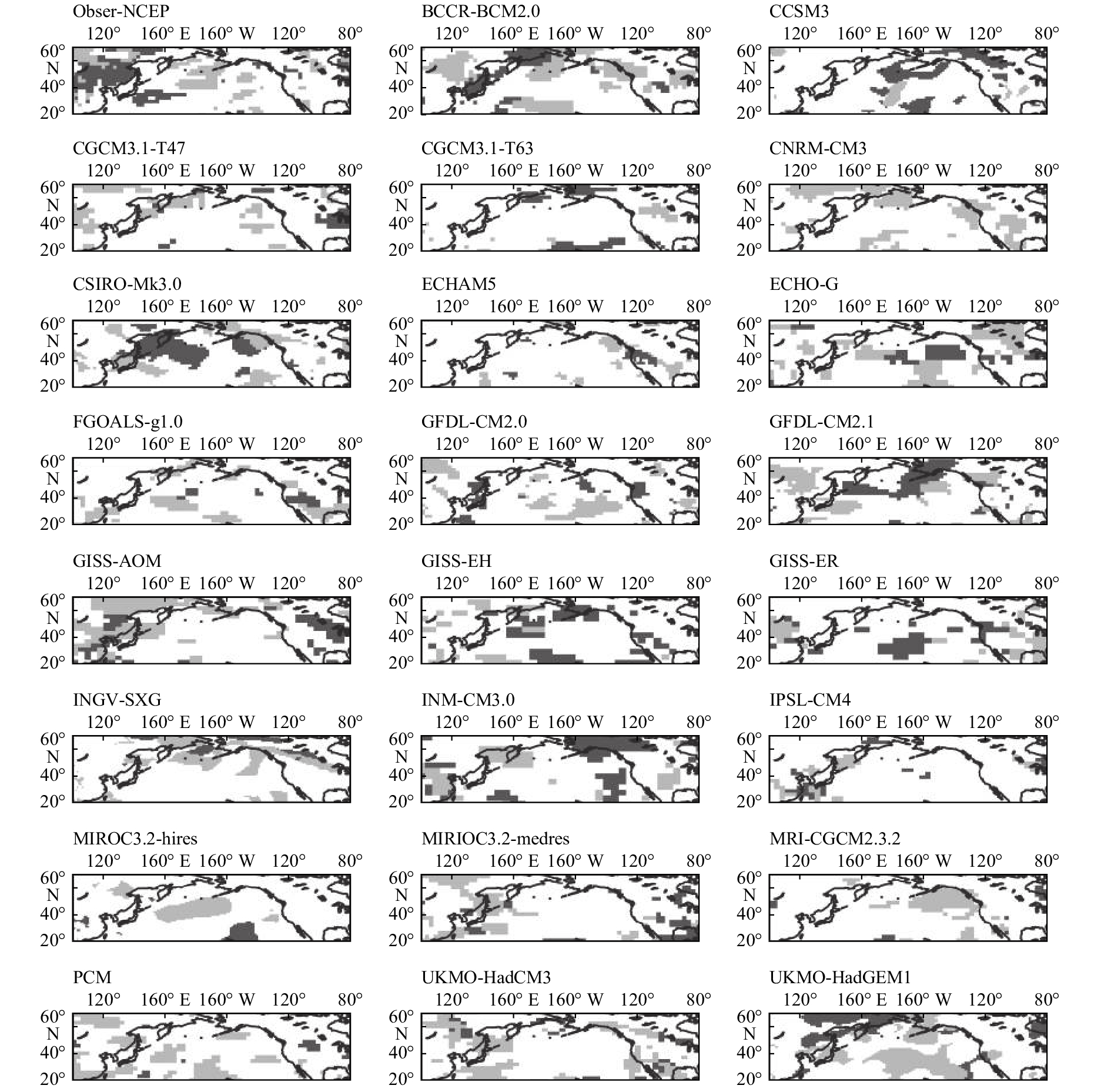The winter-to-winter recurrence in the North Pacific air-sea system: IPCC-AR4 model evaluation
-
摘要: 冬季重现(再现)是中高纬度大尺度海表温度重要的持续性特征,是热带外海洋特有的现象。北太平洋大气环流也存在这一现象,它可能会强迫产生这一海域海温的冬季重现。本文利用IPCC 20C3M耦合模式资料,评估了耦合模式模拟北太平洋海–气系统冬季重现的能力。北太平洋海温冬季重现的空间范围是海盆尺度的,中部重现时间比其周围晚。大气环流场的冬季重现主要是在北太平洋中部,它与海温冬季重现关系密切。大多数IPCC耦合模式基本上可以模拟出太平洋海温大范围的冬季重现现象。与重现范围的模拟相比,耦合模式对重现时间地理差异的模拟都比较差。各模式对大气环流冬季重现时空分布特征的模拟较差,大部分模式未能模拟出大气环流场中主要的重现区域。而且,大气环流冬季重现对海温重现的可能影响并没有体现在这些耦合模式中。耦合模式对北太平洋大气冬季重现的模拟还有待改善。Abstract: Winter-to-winter recurrence (WWR) is an important persistence characteristic of large-scale sea surface temperature anomalies (SSTAs) in middle-high latitude, which is a unique phenomenon of the extratropical ocean. Its influence on extratropical climate change can not be ignored. WWR also exist in the atmosphere in the North Pacific Ocean, which could induce SSTAs WWR. In this paper, the WWRs of the air-sea system in the North Pacific are evaluated using the model output of 23 coupled models of CMIP in IPCC 4th assessment. Observational results show that, SSTAs WWR occurs over most of the basin of North Pacific, but the recurrence timing is in winter in the central and in fall in other regions. The atmospheric WWR is mainly located in central North Pacific, which is essential for the occurrence of the SSTAs WWR. Most of models can simulate the basinwide SSTAs WWR, but they can’t reproduce the geographical distribution of recurrence timing well. Compared with the SSTAs, little skill is shown in the WWR of the atmospheric circulation in most models. Moreover, the possible effect of the atmospheric WWR on the SSTAs WWR is not reflected in these coupled models. The coupling model has yet to be improved for simulating the atmospheric WWR in the North Pacific.
-
Key words:
- North Pacific /
- air-sea system /
- persistence /
- winter recurrence /
- IPCC model evaluation
-
图 1 北太平洋海温冬季重现的时空分布(起始月为2月)
图中的阴影表示重现时间,浅色为秋季(10–12月),深色为冬季 (1–3月)
Fig. 1 Spatiotemporal distribution of the sea surface temperature anomalies winter-to-winter recurrence in the North Pacific Ocean for the starting month of February
The shading is the winter-to-winter recurrence timing, dark (light) shading indicates the recurrence timing is in winter (fall)
图 3 北太平洋大气环流冬季重现的时空分布
a. 海平面气压异常场; b. 500 hPa位势高度异常场; c. 200 hPa位势高度异常场。图中的阴影表示重现时间,浅色为秋季,深色为冬季
Fig. 3 Spatiotemporal distribution of the winter-to-winter recurrence of atmospheric circulation anomalies in the North Pacific Ocean
a. Sea level pressure anomalies; b. 500 hPa geopotential height anomalies; c. 200 hPa geopotential height anomalies. The shading is the winter-to-winter recurrence timing, dark (light) shading indicates the recurrence timing is winter (fall)
图 4 冬季北太平洋中部海平面气压与北太平洋海温的相关
浅(深)色阴影表示负(正)相关系数大于95%置信水平
Fig. 4 Correlation coefficient between the sea level pressure anomalies in the central North Pacific Ocean and the sea surface temperature anomalies in the North Pacific Ocean in winter
The light (dark) shading indicates negative (positive) correlation coefficient values with a confidence level higher than 95%
表 1 参加IPCC AR4 20C3M的23个耦合模式的基本情况
Tab. 1 Descriptions of 23 models in the IPCC AR4 20C3M archives
所属单位 国家 耦合模式 皮叶克尼斯气候研究中心 挪威 BCCR-BCM2.0 美国国家大气研究中心 美国 CCSM3 气候模拟与分析中心 加拿大 CGCM3.1-T47 气候模拟与分析中心 加拿大 CGCM3.1-T63 国家气象中心 法国 CNRM-CM3 联邦科学与工业研究组织 澳大利亚 CSIRO-Mk3.0 马普气象研究所 德国 ECHAM5/MPI-OM 波恩大学气象研究所/韩国气象局 德国/韩国 ECHO-G 大气物理研究所 中国 FGOALS-g1.0 国家大气海洋局地球物理流体力
学实验室美国 GFDL-CM2.0 国家大气海洋局地球物理流体力
学实验室美国 GFDL-CM2.1 国家航空航天局/戈达德空间研究所 美国 GISS-AOM 国家航空航天局/戈达德空间研究所 美国 GISS-EH 国家航空航天局/戈达德空间研究所 美国 GISS-ER 地球和火山科学研究所 意大利 INGV-SXG 数值数学研究所 俄罗斯 INM-CM3.0 皮埃尔西蒙拉普拉斯研究所 法国 IPSL-CM4 国家研究所气候系统研究中心 日本 MIROC3.2-hires 国家研究所气候系统研究中心 日本 MIROC3.2-medres 气象研究所 日本 MRI-CGCM2.3.2 国家大气研究中心 美国 PCM 哈德莱气候预测与研究中心 英国 UKMO-HadCM3 哈德莱气候预测与研究中心 英国 UKMO-HadGEM1 -
[1] Bjerknes J. A possible response of the atmospheric Hadley circulation to equatorial anomalies of ocean temperature[J]. Tellus, 1966, 18(4): 820−829. doi: 10.3402/tellusa.v18i4.9712 [2] Bjerknes J. Atmospheric teleconnections from the equatorial Pacific[J]. Monthly Weather Review, 1969, 97(3): 163−176. doi: 10.1175/1520-0493(1969)097<0163:ATFTEP>2.3.CO;2 [3] Namias J. Large-scale air-sea interactions over the North Pacific from summer 1962 through the subsequent winter[J]. Journal of Geophysical Research, 1963, 68(22): 6171−6186. doi: 10.1029/JZ068i022p06171 [4] Namias J. Seasonal interactions between the North Pacific ocean and the atmosphere during the 1960’s[J]. Monthly Weather Review, 1969, 97(3): 173−192. doi: 10.1175/1520-0493(1969)097<0173:SIBTNP>2.3.CO;2 [5] Namias J, Born R M. Temporal coherence in North Pacific sea-surface temperature patterns[J]. Journal of Geophysical Research, 1970, 75(30): 5952−5955. doi: 10.1029/JC075i030p05952 [6] Frankignoul C. Sea surface temperature anomalies, planetary waves, and air-sea feedback in the middle latitudes[J]. Reviews of Geophysics, 1985, 23(4): 357−390. doi: 10.1029/RG023i004p00357 [7] Glanty M H, Katz R W, Nicholls N. ENSO Teleconnections Linking Worldwide Climate Anomalies: Scientific Basis and Scietal Impact[M]. Cambridge: Cambridge University Press, 1991: 535. [8] Kushnir Y, Robinson W A, Bladé I, et al. Atmospheric GCM response to extratropical SST anomalies: synthesis and evaluation[J]. Journal of Climate, 2002, 15(16): 2233−2256. doi: 10.1175/1520-0442(2002)015<2233:AGRTES>2.0.CO;2 [9] Xie Shangping, Hu Kaiming, Hafner J, et al. Indian Ocean capacitor effect on Indo-western Pacific climate during the summer following El Niño[J]. Journal of Climate, 2009, 22(3): 730−747. doi: 10.1175/2008JCLI2544.1 [10] 巢纪平. 大尺度海气相互作用和长期天气预报[J]. 大气科学, 1977, 1(3): 223−233. doi: 10.3878/j.issn.1006-9895.1977.03.08Chao Jiping. On the large-scale interactions of sea and atmosphere and long-range weathcr forecasts[J]. Chinese Journal of Atmospheric Sciences, 1977, 1(3): 223−233. doi: 10.3878/j.issn.1006-9895.1977.03.08 [11] 王绍武. 海气相互作用与旱涝长期预报[M]. 北京: 科学出版社, 1978.Wang Shaowu. Air-sea Interaction and Long-Range Forecast of Drought and Flood[M]. Beijing: Science Press, 1978. [12] 陈烈庭. 太平洋海气相互作用的时空变化[J]. 气象学报, 1983, 41(3): 42−50.Chen Lieting. The temporal and spatial variations in air-sea interaction over the Pacific Ocean[J]. Acta Meteorologica Sinica, 1983, 41(3): 42−50. [13] 符淙斌. 全球变化中海洋–大气相互作用过程的研究[J]. 地球科学进展, 1988, 3(1): 16−18.Fu Congbin. Research on air-sea interaction under global change[J]. Advances in Earth Science, 1988, 3(1): 16−18. [14] 赵永平, 陈永利, 翁学传. 中纬度海气相互作用研究进展[J]. 地球科学进展, 1997, 12(1): 32−36.Zhao Yongping, Chen Yongli, Weng Xuezhuan. Advances in the mid-latitude Air-Sea interaction research[J]. Advances in Earth Science, 1997, 12(1): 32−36. [15] 俞永强, 陈文. 海–气相互作用对我国气候变化的影响[M]. 北京: 气象出版社, 2005.Yu Yongqiang, Chen Wen. The Impact of Air-Sea Interaction on Climate Change in China[M]. Beijing: China Meteorological Press, 2005. [16] 周天军, 宇如聪, 郜永祺, 等. 北大西洋年际变率的海气耦合模式模拟 I: 局地海气相互作用[J]. 气象学报, 2006, 64(1): 1−17. doi: 10.3321/j.issn:0577-6619.2006.01.001Zhou Tianjun, Yu Rucong, Gao Yongqi, et al. Ocean-atmosphere coupled model simulation of North Atlantic interannual variability I: local air-sea interaction[J]. Acta Meteorologica Sinica, 2006, 64(1): 1−17. doi: 10.3321/j.issn:0577-6619.2006.01.001 [17] 吴国雄, 刘屹岷, 宇婧婧, 等. 海陆分布对海气相互作用的调控和副热带高压的形成[J]. 大气科学, 2008, 32(4): 720−740. doi: 10.3878/j.issn.1006-9895.2008.04.03Wu Guoxiong, Liu Yimin, Yu Jingjing, et al. Modulation of land-sea distribution on air-sea interaction and formation of subtropical anticyclone[J]. Chinese Journal of Atmospheric Sciences, 2008, 32(4): 720−740. doi: 10.3878/j.issn.1006-9895.2008.04.03 [18] 王东晓, 方国洪, 王启, 等. 热带太平洋环流变异与海气相互作用[M]. 北京: 海洋出版社, 2009.Wang Dongxiao, Fang Guohong, Wang Qi, et al. Variation of Circulation and Air-Sea Interaction in the Tropical Pacific[M]. Beijing: China Ocean Press, 2009. [19] 李建平, 吴国雄, 胡敦欣. 亚印太交汇区海气相互作用及其对我国短期气候的影响[M]. 北京: 气象出版社, 2011.Li Jianping, Wu Guoxiong, Hu Dunxin. Air-Sea Interaction at the Asian-Indian-Pacific Intersection and its Impact on Short-Term Climate in China[M]. Beijing: China Meteorological Press, 2011. [20] 刘秦玉, 谢尚平, 郑小童. 热带海洋–大气相互作用[M]. 北京: 高等教育出版社, 2013.Liu Qinyu, Xie Shangping, Zheng Xiaotong. Tropical Ocean-Atmosphere Interaction[M]. Beijing: Higher Education Press, 2013. [21] 张学洪, 俞永强, 周天军, 等. 大洋环流和海气相互作用的数值模拟讲义[M]. 北京: 气象出版社, 2013.Zhang Xuehong, Yu Yongqiang, Zhou Tianjun, et al. Handout on Numerical Simulation of Ocean Circulation and Air-Sea Interaction[M]. Beijing: China Meteorological Press, 2013. [22] 付建建, 李双林, 王彦明. 前期海洋热状况异常影响 2008 年 1 月雪灾形成的初步研究[J]. 气候与环境研究, 2008, 13(4): 478−490.Fu Jianjian, Li Shuanglin, Wang Yanming. Influence of prior thermal state of global oceans on the formation of the disastrous snow storm in January 2008[J]. Climatic and Environmental Research, 2008, 13(4): 478−490. [23] An S I, Wang B. The forced and intrinsic low-frequency modes in the North Pacific[J]. Journal of Climate, 2004, 18(6): 876−885. [24] Jiang Lei, Zhao Xia, Li Nana, et al. Different multifractal scaling of the 0 cm average ground surface temperature of four representative weather stations over China[J]. Advances in Meteorology, 2013(24): 1−8. doi: 10.1155/2013/341934 [25] Jiang Lei, Li Nana, Zhao Xia. Scaling behaviors of precipitation over China[J]. Theoretical and Applied Climatology, 2015, 128(1/2): 63−70. [26] 时少英, 刘式达, 付遵涛, 等. 天气和气候的时间序列特征分析[J]. 地球物理学报, 2005, 48(2): 259−264. doi: 10.3321/j.issn:0001-5733.2005.02.004Shi Shaoying, Liu Shida, Fu Zuntao, et al. The characteristic analysis of weather and climate time series[J]. Chinese Journal of Geophysics, 2005, 48(2): 259−264. doi: 10.3321/j.issn:0001-5733.2005.02.004 [27] 李建平, 丁瑞强, 陈宝花. 大气可预报性研究的回顾与展望[C]//第四次全国大气科学前沿学科研讨会论文集. 北京: 气象出版社, 2005.Li Jianping, Ding Ruiqiang, Chen Baohua. Review and prospect of atmospheric predictability research[C]//Proceedings of the Fourth National Symposium on Frontier Disciplines of Atmospheric Science. Beijing: China Meteorological Press, 2005. [28] 王启光, 侯威, 郑志海. 东亚区域大气长程相关性[J]. 物理学报, 2009, 58(9): 6640−6650. doi: 10.3321/j.issn:1000-3290.2009.09.122Wang Qiguang, Hou Wei, Zheng Zhihai. The long range correlation of East Asia' s atmosphere[J]. Acta Physica Sinica, 2009, 58(9): 6640−6650. doi: 10.3321/j.issn:1000-3290.2009.09.122 [29] Namias J. Recent seasonal interactions between North Pacific waters and the overlying atmospheric circulation[J]. Journal of Geophysical Research, 1959, 64(6): 631−646. doi: 10.1029/JZ064i006p00631 [30] Namias J, Born R M. Further studies of temporal coherence in North Pacific sea surface temperatures[J]. Journal of Geophysical Research, 1974, 79(6): 797−798. doi: 10.1029/JC079i006p00797 [31] Alexander M A, Deser C. A mechanism for the recurrence of wintertime midlatitude SST anomalies[J]. Journal of Physical Oceanography, 1995, 25(1): 122−137. doi: 10.1175/1520-0485(1995)025<0122:AMFTRO>2.0.CO;2 [32] Zhao Xia, Li Jianping. Winter-to-winter recurrence of sea surface temperature anomalies in the Northern Hemisphere[J]. Journal of Climate, 2010, 23(14): 3835−3854. doi: 10.1175/2009JCLI2583.1 [33] Liu Zhengyu, Liu Yun, Wu Lixin, et al. Seasonal and long-term atmospheric responses to reemerging north Pacific ocean variability: a combined dynamical and statistical assessment[J]. Journal of Climate, 2007, 20(6): 955−980. doi: 10.1175/JCLI4041.1 [34] Cassou C, Deser C, Alexander M A. Investigating the impact of reemerging sea surface temperature anomalies on the winter atmospheric circulation over the north Atlantic[J]. Journal of Climate, 2007, 20(14): 3510−3526. doi: 10.1175/JCLI4202.1 [35] de Coëtlogon G, Frankignoul C. The persistence of winter sea surface temperature in the North Atlantic[J]. Journal of Climate, 2003, 16(9): 1364−1377. doi: 10.1175/1520-0442-16.9.1364 [36] Alexander M A, Deser C, Timlin M S. The reemergence of SST anomalies in the North Pacific Ocean[J]. Journal of Climate, 1999, 12(8): 2419−2433. doi: 10.1175/1520-0442(1999)012<2419:TROSAI>2.0.CO;2 [37] Watanabe M, Kimoto M. On the persistence of decadal SST anomalies in the North Atlantic[J]. Journal of Climate, 2000, 13(16): 3017−3028. doi: 10.1175/1520-0442(2000)013<3017:OTPODS>2.0.CO;2 [38] Taws S L, Marsh R, Wells N C, et al. Re-emerging ocean temperature anomalies in late-2010 associated with a repeat negative NAO[J]. Geophysical Research Letters, 2011, 38(20): L20601. [39] 王晓娟, 乔少博, 沈柏竹, 等. 东亚北部地区气温的冬季–冬季再现特征研究[J]. 物理学报, 2014, 63(23): 239202. doi: 10.7498/aps.63.239202Wang Xiaojuan, Qiao Shaobo, Shen Baizhu, et al. Characteristics of winter-to-winter recurrence of atmospheric temperature in the northern area of East Asia[J]. Acta Physica Sinica, 2014, 63(23): 239202. doi: 10.7498/aps.63.239202 [40] Zhao Xia, Li Jianping. Winter-to-winter recurrence and non-winter-to-winter recurrence of SST anomalies in the central North Pacific[J]. Journal of Geophysical Research: Oceans, 2012, 117(C5): C05027. [41] Zhao Xia, Li Jianping. Winter-to-winter recurrence of atmospheric circulation anomalies in the central North Pacific[J]. Journal of Geophysical Research: Oceans, 2012, 117(C12): C12023. [42] Solomon S, Qin D, Manning M, et al. Climate Change 2007: The Physical Science Basis. Contribution of Working Group I to the Fourth Assessment Report of the Intergovernmental Panel on Climate Change[M]. Cambridge: Cambridge University Press, 2007: 996. [43] Smith T M, Reynolds R W. Improved extended reconstruction of SST (1854–1997)[J]. Journal of Climate, 2004, 17(12): 2466−2477. doi: 10.1175/1520-0442(2004)017<2466:IEROS>2.0.CO;2 [44] Kalnay E, Kanamitsu M, Kistler R, et al. The NCEP/NCAR 40-year reanalysis project[J]. Bulletin of the American Meteorological Society, 1996, 77(3): 437−472. doi: 10.1175/1520-0477(1996)077<0437:TNYRP>2.0.CO;2 [45] Timlin M S, Alexander M A, Deser C. On the reemergence of North Atlantic SST anomalies[J]. Journal of Climate, 2002, 15(18): 2707−2712. doi: 10.1175/1520-0442(2002)015<2707:OTRONA>2.0.CO;2 -





 下载:
下载:







